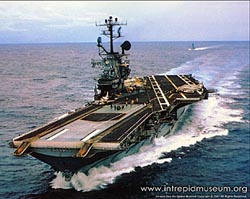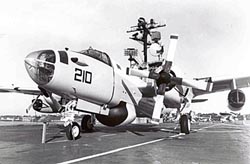
Located in Manhattan, New York, the USS Intrepid, the third Essex class carrier built by the United States, was laid down at the Newport News Shipbuilding and Drydock Company of Virginia and commissioned on August 16, 1943. As early as 1910, the U.S. Navy recognized the potential value that flight would have in naval operations. Although naval aviation was utilized during World War I, aircraft assigned to warships generally provided only reconnaissance support for the fleet. The possibility of using airplanes as a naval strike weapon did not begin until the 1920s when aircraft capable of performing heavy bombardment against land or sea targets were built. Naval vessels capable of carrying several squadrons of such aircraft were developed concurrently. Thus the first eight carriers constructed by the U.S. Navy varied in size, speed, protection and aircraft complement in order to provide the greatest number of carriers capable of launching the greatest number of air strikes, yet still comply with treaty-imposed tonnage restrictions. Essex (CV-9), the ninth U.S. carrier authorized, was a product of these earlier designs. A total of 26 Essex-class carriers were ordered by the U.S. Navy between February 1940 and June 1943 and 24 were completed. This was the largest class of carriers ever built by the United States and over half, including USS Intrepid (CV-11), served as part of the Pacific Fleet during World War II.
World War II and the carrier campaigns of the Pacific firmly established the role of aviation within naval operations and the aircraft carrier replaced the battleship as the Navy's primary strike weapon. Serving as mobile air bases, carriers could maneuver aircraft around the open waters and scattered island chains of the Pacific. By employing a combination of scouting, fighter or bomber aircraft to control the enemy's air power, groups of carriers, screened by surface ships, could open the way for island invasions, cover and support amphibious operations, and help to hold the conquered areas. Thus carriers became an integral compound of nearly every campaign throughout the Pacific War. With aircraft that extended the fleet's firepower beyond the range of large caliber battleship guns, the carrier's status was elevated from reconnaissance platform to that of major surface combatant.

In two years of fighting against the Japanese the USS Intrepid was hit by enemy action on five occasions and took part in the largest naval battle in history, the Battle of Leyte Gulf in 1944. The USS Intrepid helped sink both of Japan's super-battleships, Yamato and Musashi. Five battle stars were awarded to the USS Intrepid for its World War II service. The USS Intrepid was extensively modernized by the Navy in 1954, converting it to a modern attack carrier capable of handling jets. All heavy guns were removed, the centerline elevator was removed and a new heavy-duty starboard side elevator was installed. The USS Intrepid is now operated as a memorial and museum ship.
Visit the National Park Service Travel American Aviation to learn more about Aviation related Historic Sites.
A project through the Save America's Treasures Grant Program, which helps preserve nationally significant historic properties and collections, funded construction work at the USS Intrepid Museum to build a new entrance center in 2000.
Tags
Last updated: April 12, 2024
